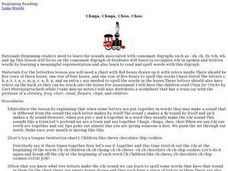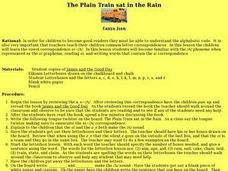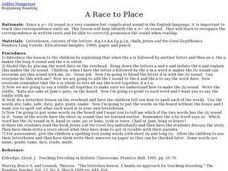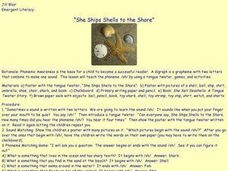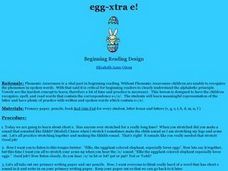Curated OER
Capital letter A
In this alphabet worksheet, students will cut out the letter A. Students will then cut out 16 pictures and glue those that begin with the letter A onto the large letter.
Curated OER
Building a Native American Home
First graders explore different types of Native American shelters. In this Native American homes lesson, 1st graders compare the shapes of shelters used by Native Americans. They build a home using the program "Community Construction...
Curated OER
Beginning Consonants
In this alphabet worksheet, students focus on the beginning consonant sounds of words. Students study 5 rows of pictures and circle the picture that begins with the letter that is shown for each row.
Curated OER
Teaching English: The Weather
In this weather worksheet, students discuss differences in sets of weather related words, match the phonemic pronunciation of beginnings of words with endings, match adjectives to form collocations, and complete short answer questions.
Curated OER
Spelling List 32: Sight Words, /oo/ Words, and Academic Vocabulary
In this spelling list worksheet, students practice spelling words that are sight words, oo words, and vocabulary. Students practice spelling 21 words total.
Curated OER
Wemberly's Wonderful Wonders
Students examine the letter 'w'. Through instruction and modeling they explore the sound the letter makes, how the letter is written, words that contain the letter, etc. They read "Wemberly Worried" to hear words with a 'w' in them.
Curated OER
Chuga Chuga Choo Choo
First graders identify the digraph /ch/ in written and spoken language. After a brief discussion of the independent and combined sounds of the phonemes /c/ and /h/ students practice identifying initial and final placement of the new...
Curated OER
Ehhh?? I Can't Hear You!
Students identify the /e/ sound in spoken words in this lesson. They say a tongue twister with words emphasizing the short /e/ sound. They then listen to the story "Peg the Hen" and do an "I Can't Hear You" motion whenever they hear...
Curated OER
Don't Wake Mama
Young scholars identify the digraph /sh/ in written and spoken language. After a brief discussion of the independent and combined sounds of the phonemes /s/ and /h/ students practice identifying initial and final placement of the new...
Curated OER
Phonetics Exercises: Words with Short /a/
In this short /a/ interactive worksheet, learners use drop down menus to choose the picture that matches the short /a/ word in 4 examples. They use drop down menus and fill in the blanks to complete 20 sentence. They insert the letter a...
Curated OER
The Plain Train sat in the Rain
Students study the ai=/A/ grapheme by reading "James and the Good Day" with a partner and discussing it. Next, they recite a tongue twister focusing on the ai=/A/ correspondence. They make words using their letterboxes and letters before...
Curated OER
Duh!
Students practice discerning between the letters and sounds for the lower case letters b and d. Through practice activities, they recognize the difference between the commonly confused letters b and d. They practice writing both letters...
Curated OER
Musical Concept
Fourth graders practice musical forms to be able to recognize similar and different sections to a song. They review that music has a beginning, middle and an end and discover this process through the "Viennese Musical Clock" that...
Curated OER
Beginning Letters Matching
In this beginning letters worksheet, students draw lines to match pictures with their beginning letters; letters used are b, f, d and h.
Curated OER
Words with Short A, Short I, and Short O #3
In this short a, short i, and short o worksheet, students match words to pictures, complete the sentences, label pictures, and more with the short vowels. Students complete 4 activities.
Curated OER
Speedy, Speedy Students Reading Fast
Young scholars review basic reading decoding. Given books at their independent reading level, they read independently and with several different partners to increase reading fluency. They see how many more words per minute they can read...
Curated OER
A Race to Place
Students distinguish between short vowel a and long vowel a. They are introduced to the vowel-consonant-e pattern that changes short vowel sounds into long vowel sounds. They practice spelling words with the vowel-consonant-e pattern.
Curated OER
Baby Brown Bears
Students identify the letter and phoneme /b/ in written and spoken language. Students practice the production of the /b/ sound through riddles and tongue twisters. They identify the initial placement of the letter and sound using a...
Curated OER
Letter Recognition Flash Games for Kids
Young scholars explore the alphabet by completing an on-line letter identification activity. For this phonetics lesson, students utilize the website www.literarycenter.net and listen to word sounds as they identify the spelling of the...
Curated OER
She Ships Shells to the Shore
First graders identify the digraph /sh/ in written and spoken language. After a brief discussion the independent and combined sounds of the phonemes /s/ and /h/ students practice identifying initial and final placement of the new digraph...
Curated OER
Icky Sticky
Students recognize the short vowel i in written and spoken language. Through matching and listening activities, they discriminate the vowel sound /i/ from other phonemes. Students identify the phoneme and letter in pseudo words they read.
Curated OER
Egg-xtra E!
First graders recognize the short vowel e in written and spoken language. Through listening activities, they discriminate the vowel sound /e/ from other phonemes. Students identify the phoneme and letter in words and sentences they write.
Curated OER
Icky Sticky Tin Man
Learners recognize the short vowel i in written and spoken language. Through listening and matching activities, they discriminate the vowel sound /i/ from other phonemes. Students associate the phoneme with its letter representation and...
Curated OER
O-o-o-oh, no-o-o-o!!
Students engage in an emergent literacy lesson in order to practice the skill of phonemic awareness. They learn this skill using the phoneme for the letter "o". Students must recognize the letter as well as its sound.






